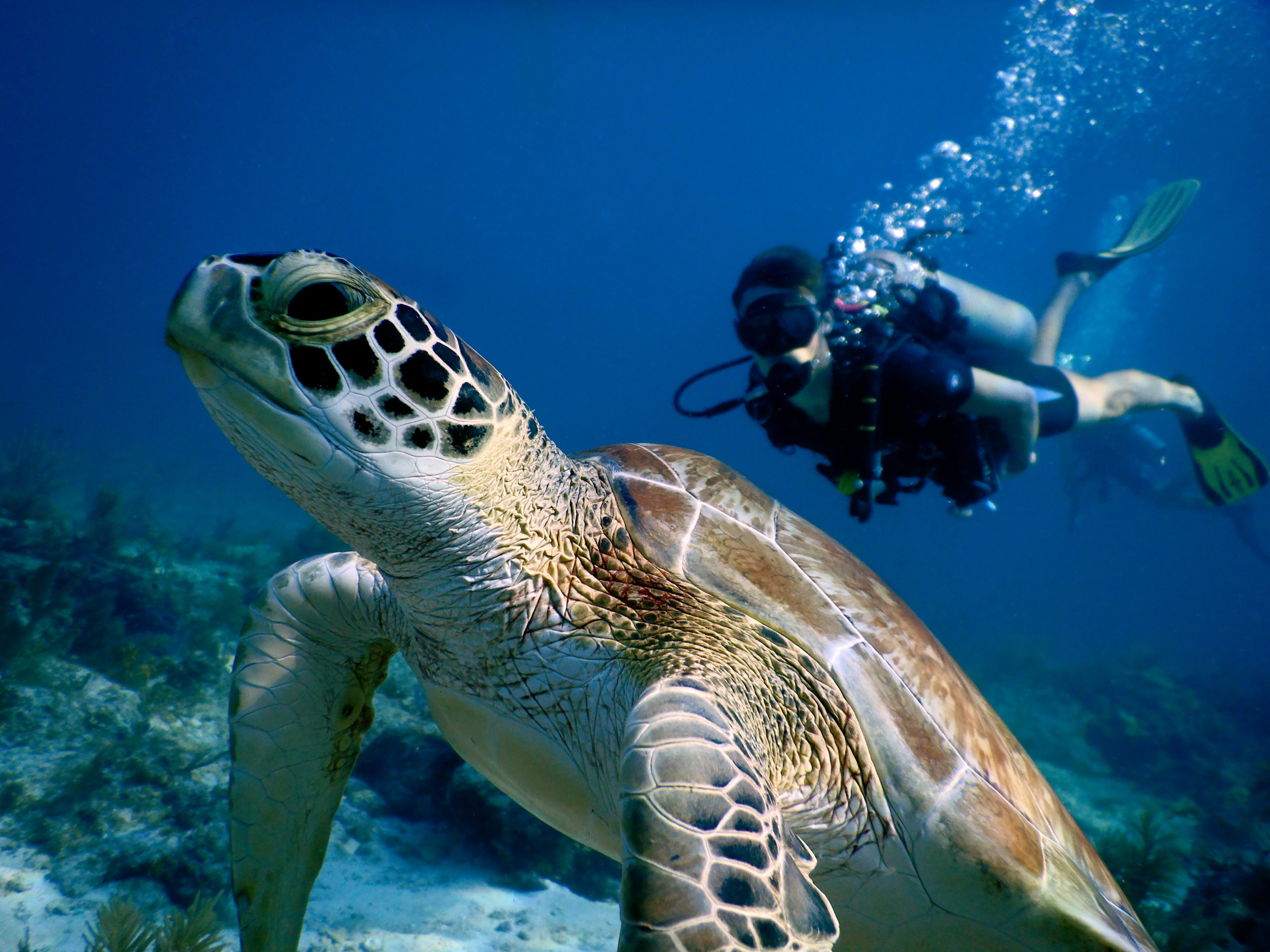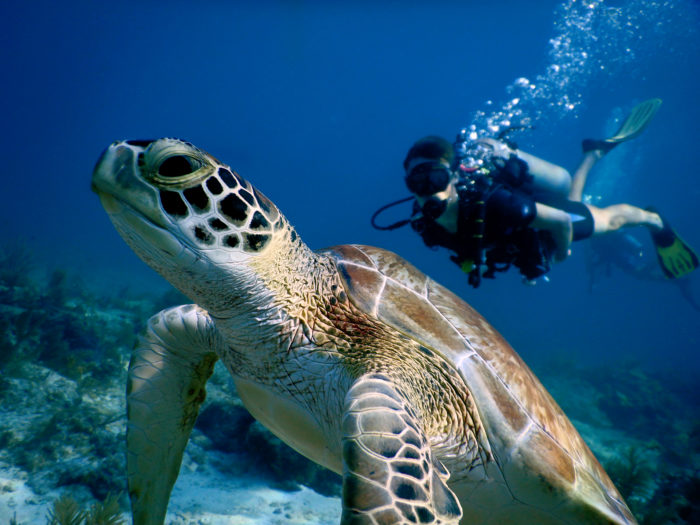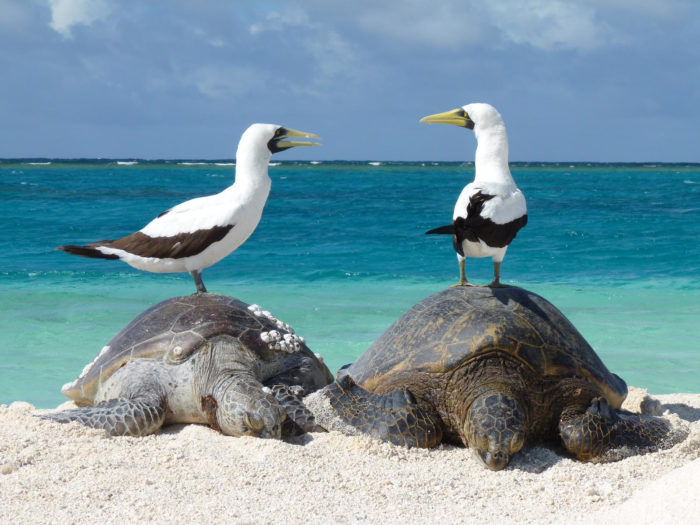
Sea Wonder: Green Sea Turtle

A diver swims behind a green sea turtle in Florida Keys National Marine Sanctuary. Photo credit: Olivia Williamson
The green sea turtle (Chelonia mydas) is one of the seven sea turtle species that inhabits the global ocean. They are the largest of all the hard-shelled sea turtles and the only one with a strictly herbivorous diet. You may recognize this species from a popular family movie about a missing clownfish. If you do, you know they so totally rock!
DESCRIPTION
Green turtles get their name from the color of their bodies, but it isn’t their skin that is green — it’s their fat cells, which get their coloration from their vegetation-rich diet! The turtles’ shells, which cover all of the animals’ bodies except for their heads and flippers, are darker in color, usually some combination of brown, olive, gray, or black, and their undersides are a lighter yellowish-white color. On their heads are yellow or brown markings that are unique to each individual. Like all other sea turtles, green turtles must surface to breathe oxygen, though not frequently due to their lower metabolic rates, and nostrils on their heads help them to do so.
Green sea turtles have four paddle-shaped flippers that allow them to move quickly and effortlessly through the ocean. Other distinctive characteristics are the two large scales located between their eyes and their serrated beak on their lower jaws. They can reach lengths of four feet and weigh anywhere from 300 to 350 pounds. Males are, on average, slightly larger than females when fully grown.
DIET & HABITAT
Green sea turtles mostly munch on algae and sea grasses in adulthood, making them the only herbivorous species of sea turtles. Juveniles and adults that don’t have other options may also eat sponges, small invertebrates, and small fish. The foods they eat most often depend on where they live, with individuals living in shallower waters often graze on species found in permanent seagrass beds or algae that grow on rocks and other fixed structures, while individuals traveling further offshore will eat marine vegetation floating through the water column. Green sea turtles serve important roles in keeping seagrass beds (and their surrounding ecosystems) healthy, operating like lawn mowers that remove sick or dead grasses and making room for new or faster growth.
Green turtles live throughout the global ocean, primarily in subtropical and temperate regions of the Atlantic, Pacific, and Indian Oceans, and in the Mediterranean Sea. They are highly migratory, traveling long distances in the ocean immediately after hatching and making their way into the ocean. As hatchlings, surviving turtles often float passively in oceanic currents until they reach a size where they can swim against the flowing waters. Adults often live along coral reefs, seagrass beds, and mangrove forests, traveling ashore every few years to nest. Birds, fish, crabs, and mammals prey upon hatchlings and juveniles, and adult green sea turtles are the targets of some larger species of shark.
In the United States, we see them most often in the southeast, Caribbean, and the Pacific Islands. Nesting turtles are found in the waters near the Hawaiian Islands, U.S. Pacific Island territories (Guam, American Samoa, and the Commonwealth of the Northern Mariana Islands), Puerto Rico, the Virgin Islands, and Florida. In the lower 48, females travel ashore to lay their eggs each year in Georgia, South Carolina, North Carolina, and Texas.
In Hawaii, green sea turtles (called honu) are common sights in nearshore waters, along with four other species of sea turtle. 96 percent of the state’s green sea turtles nest on the shores of Papahānaumokuākea Marine National Monument in the northwestern Hawaiian Islands.
National Marine Sanctuaries and Marine National Monuments where we can find green sea turtles:
- Florida Keys
- Gray’s Reef
- Hawaiian Islands Humpback Whale
- National Marine Sanctuary of American Samoa
- Papahānaumokuākea Marine National Monument
- Rose Atoll Marine National Monument
LIFE HISTORY
Green sea turtles are a longer-living species and may live to be 80 years or more. Their life cycle begins when they hatch from their eggs, buried in dense nests under the sand. The hatchlings dig out from the nest and make their way to the water. Many hatchlings don’t survive their first years, but those that do enter their juvenile phase, which is unusually long. It can take nearly 20 years for them to reach their full size and sexual maturity. When they do achieve adulthood, males and females mate on foraging grounds, along migratory routes, and off of their nesting beaches. In the United States, green turtle mating season begins in the late spring when temperatures are warmer (but not too hot) and food is more plentiful. Nesting has to occur on land.
Individual females will travel back to the same beaches from which they hatched every two to five years to lay eggs; males can mate every year. In each nest buried in the sand could be anywhere from 50 to 200 eggs, and the temperature of the surrounding environment determines the sex of each hatchling. Females do not play any role in guarding her nests or raising her hatchlings. Incubation takes about two months when conditions are just right, and hatchlings are highly vulnerable to predation, exposure to the intense elements (like heat and sunlight), or losing their way, which is especially common when anthropogenic lights are located near the beach.
THREATS & CONSERVATION
Throughout their range, green sea turtles are considered endangered on the IUCN’s Red List due to an estimated 90 percent population decrease over the last 50 years. In the United States, NOAA Fisheries and the U.S. Fish and Wildlife Service have overseen green turtle conservation and recovery since the species has been listed on the Endangered Species List since 1977. Internationally, these turtles receive protections from Annex II of the SPAW Protocol to the Cartagena Convention; Appendix I of CITES; and Appendices I and II of the Convention on Migratory Species.
Green sea turtle populations are vulnerable to decline because of increasing anthropogenic impacts and changing ocean conditions. Perhaps the most damaging human activity for this species is intentional harvests of eggs and adults from nesting beaches or juveniles and adults from foraging grounds. Other threats they face include bycatch and entanglement in fishing gear, habitat degradation, pollution and marine debris, and climate change effects.
NOAA’S National Marine Fisheries Service conducts regular research on and monitoring of green sea turtle populations. Restoration efforts are underway in places like the Gulf of Mexico, where nesting beaches are being restored and enhanced. In Florida, many coastal communities have developed and implemented lighting ordinances to help more hatchlings reach the sea by minimizing the use of artificial lighting during nesting season. Bycatch (accidental capture by commercial and sport fishermen) of green sea turtles is being reduced thanks to fishing gear modifications (such as the use of Turtle Exclusion Devices, or TEDs), changes to fishing practices, and closures of certain areas to fishing during nesting and hatching seasons.

Birds sit atop two green sea turtles resting on the beach in Papahānaumokuākea Marine National Monument. Photo credit: Mark Sullivan
